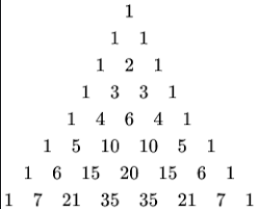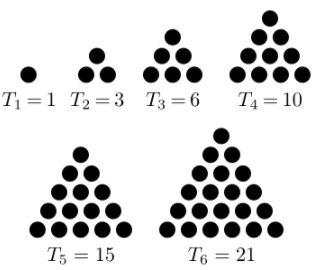Hello, and welcome back to another blog! This series will have a slightly different flavor then the last one, as we will begin by touching a bunch of different elements and patterns in pascals triangle, and then look at each of them deeper in future blogs! Also, if you end up liking this blog, go check out my series on modular arithmetic!
The basics
To begin, we will first look at a couple easier to understand patterns in Pascal’s triangle, then look at some of the less obvious patterns.

If you didn’t already know, Pascal’s triangle is formed starting with a 1 at the top, and for each cell below, adding the 1 or 2 cells above to get a new number. Now, the first pattern we will look at is in the 1st 2nd and 3rd diagonals of the triangle:
- 1st diagonal: This diagonal is all 1’s, very simple
- 2nd diagonal: Once again, it is only the counting numbers. Simple!
- 3rd diagonal: This one is harder to see, so I will first list the entries in this diagonal:
1, 3, 6, 10, 15, 21, 28
Now, we will define the triangular numbers as so, where Tn is the nth triangular number:
Tn=1+2+3+…+n
This can also be thought of as the number of dots in the following triangles:

Thus the name ‘triangular numbers.’ You might notice that these triangular numbers line up with the third diagonal numbers, pretty neat! All 3 of these properties (And more) end up falling under a more general property called the hockey stick principle, which we will state and maybe prove in the next part.
Choosing things
The next pattern we will discus has to do with combinatorics! To start, we will define a choose b, as the number of ways to choose b objects out of a set of a objects. So, if a is 5, we get:
- 5 choose 0 is 1 (There is 1 way to pick 0 objects, that is, doing nothing)
- 5 choose 1 is 5
- 5 choose 2 is 10 (You can write down all the combinations your self if you would like, but it does come out to 10)
- 5 choose 3 is 10 (Same as above)
- 5 choose 4 is 5
- 5 choose 5 is 1
Now, look at the 6th row of Pascal’s triangle. We get 1, 5, 10, 10, 5, 1, which matches up with the number of choices with 5 objects. It’s tricky to prove why this pattern works, so we will leave it for the 3rd blog in this series.
Probability
This is the last topic we will go over today, and it has to do with flipping coins. So, imagine we flip a coin 6 times. We will be looking at the probability of getting n heads out of those coin flips. So, if you would like, feel free to get a coin out and test it yourself a few time to estimate a probability, maybe code a script to do it automatically, or just keep reading and do neither of those things! If you did test out the probability, you probably got something similar to this:
0 Heads: 1.5%
1 Head: 9.4%
2 Heads: 23.4%
3 Heads: 31.3%
4 Heads: 23.4%
5 Heads: 9.4%
6 Heads: 1.5%
Or in fraction form:
0 Heads: 1/64
1 Head: 6/64
2 Heads: 15/64
3 Heads: 20/64
4 Heads: 15/64
5 Heads: 6/64
6 Heads: 1/64
1, 6, 15, 20, 15, 6, 1. You guessed it! They’re entries in Pascal’s triangle! These probabilities are linked very closely with combinatorics (You may see the link already!), but unlike combinatorics, they will be easy to link with binomials. But that will be a topic for the 3rd and 4th blogs.
Conclusion
I was a bit all over the place this blog, but hopefully I presented a good map of sorts for how the rest of this series will go. Anyway, I’ll see you all next time when we discus the hockey stick principle, and until then, have a great day!
How did you get the probability of the coin flips?
(New blog: http://blogs.atharvnadkarni.com/RecSeq)